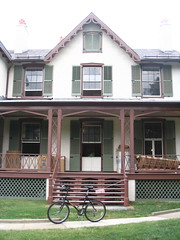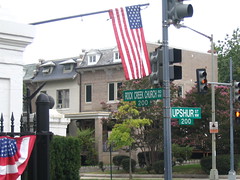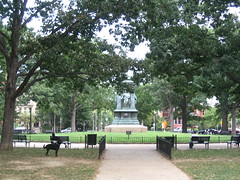by Matt Ringelstetter
 Commuting to work is one aspect of living in our nation’s capital that most residents can relate to—even the most prominent. During the summer months, Abraham Lincoln traveled daily from the Soldiers’ Home to the White House in the mornings, and back again during the evening hours. Waking up early, the President consumed a small meal of toast and eggs, and made it in to work around 8 a.m. While he most likely did not have to deal with the gridlock that is becoming infamous to our city, he did have to travel approximately three miles by horseback surrounded by a noisy Presidential guard—a bumpy and loud way to start the workday. Today, recreating Lincoln’s commute by car can be tricky, as a few of the streets have become one-way, and access near the White House has been cut off for years. By bike, however, one can easily follow the three mile route from Cottage to White House without any directional problems, and that is exactly what I did this morning.
Commuting to work is one aspect of living in our nation’s capital that most residents can relate to—even the most prominent. During the summer months, Abraham Lincoln traveled daily from the Soldiers’ Home to the White House in the mornings, and back again during the evening hours. Waking up early, the President consumed a small meal of toast and eggs, and made it in to work around 8 a.m. While he most likely did not have to deal with the gridlock that is becoming infamous to our city, he did have to travel approximately three miles by horseback surrounded by a noisy Presidential guard—a bumpy and loud way to start the workday. Today, recreating Lincoln’s commute by car can be tricky, as a few of the streets have become one-way, and access near the White House has been cut off for years. By bike, however, one can easily follow the three mile route from Cottage to White House without any directional problems, and that is exactly what I did this morning.
 Leaving the Cottage and passing through the Eagle Gate, Lincoln turned left onto Rock Creek Church Road. During the nineteenth century, this was a winding dirt road that led to several area wartime hospitals. Living so close to these hospitals and the soldiers who were being admitted to them was a constant reminder to the effects of the war. Today, Rock Creek Church follows the tree lined perimeter of the Soldiers’ Home, and slopes gently downhill, offering a pleasant start to my bicycle ride—especially after riding uphill for a half hour in order to get to the Cottage.
Leaving the Cottage and passing through the Eagle Gate, Lincoln turned left onto Rock Creek Church Road. During the nineteenth century, this was a winding dirt road that led to several area wartime hospitals. Living so close to these hospitals and the soldiers who were being admitted to them was a constant reminder to the effects of the war. Today, Rock Creek Church follows the tree lined perimeter of the Soldiers’ Home, and slopes gently downhill, offering a pleasant start to my bicycle ride—especially after riding uphill for a half hour in order to get to the Cottage.
Georgia Ave and Florida Ave
 At the intersection of Rock Creek Church and the Seventh Street Turnpike (now Georgia Avenue) the President turned left and headed south towards the city. Along this road, Lincoln would have been greeted by farmers who were delivering fresh produce from their fields in Maryland to markets in downtown Washington, D.C. Today, Georgia Ave. is home to some of the most diverse and eclectic restaurants, shops and people one will find anywhere in the District. This area is also home to Howard University, the number one producer of African American PhD’s in the country. After traveling a mile and a half on the Seventh Street Turnpike, Lincoln and his party crossed Florida Avenue, and what was then the boundary line between Maryland and D.C.
At the intersection of Rock Creek Church and the Seventh Street Turnpike (now Georgia Avenue) the President turned left and headed south towards the city. Along this road, Lincoln would have been greeted by farmers who were delivering fresh produce from their fields in Maryland to markets in downtown Washington, D.C. Today, Georgia Ave. is home to some of the most diverse and eclectic restaurants, shops and people one will find anywhere in the District. This area is also home to Howard University, the number one producer of African American PhD’s in the country. After traveling a mile and a half on the Seventh Street Turnpike, Lincoln and his party crossed Florida Avenue, and what was then the boundary line between Maryland and D.C.
Logan Circle
 Another quarter of a mile down the road, the President reached Rhode Island Ave, where he turned his horse right towards Logan Circle, then known as Iowa Circle. It was in this area where the United States Army stationed its Contraband Camp headquarters. Here, escaped slaves received passes that ensured them Army protection. The whole concept of the camps is an extremely interesting one, as these were escaped slaves, but not yet entirely free. Today, Logan Circle is popular among humans and canines as a place to play catch and just generally relax during the warm summer days.
Another quarter of a mile down the road, the President reached Rhode Island Ave, where he turned his horse right towards Logan Circle, then known as Iowa Circle. It was in this area where the United States Army stationed its Contraband Camp headquarters. Here, escaped slaves received passes that ensured them Army protection. The whole concept of the camps is an extremely interesting one, as these were escaped slaves, but not yet entirely free. Today, Logan Circle is popular among humans and canines as a place to play catch and just generally relax during the warm summer days.
Vermont Ave. at Logan Circle
 Turning south onto Vermont Ave. the President was getting closer to the heart of the city. It was at the corner of Vermont and L Street that the poet Walt Whitman lived during the Civil War. Whitman wrote about seeing the President every morning and that the two eventually came to bowing heads in acknowledgement. Today, the corners of Vermont and L are home to a Starbucks and an Au Bon Pain.After passing Walt, Lincoln and his guard reached Pennsylvania Avenue, and his place of employment—the White House. In total Lincoln had about a 30 minute commute, meaning the President probably spent less time getting to work than most D.C. residents today.
Turning south onto Vermont Ave. the President was getting closer to the heart of the city. It was at the corner of Vermont and L Street that the poet Walt Whitman lived during the Civil War. Whitman wrote about seeing the President every morning and that the two eventually came to bowing heads in acknowledgement. Today, the corners of Vermont and L are home to a Starbucks and an Au Bon Pain.After passing Walt, Lincoln and his guard reached Pennsylvania Avenue, and his place of employment—the White House. In total Lincoln had about a 30 minute commute, meaning the President probably spent less time getting to work than most D.C. residents today.

